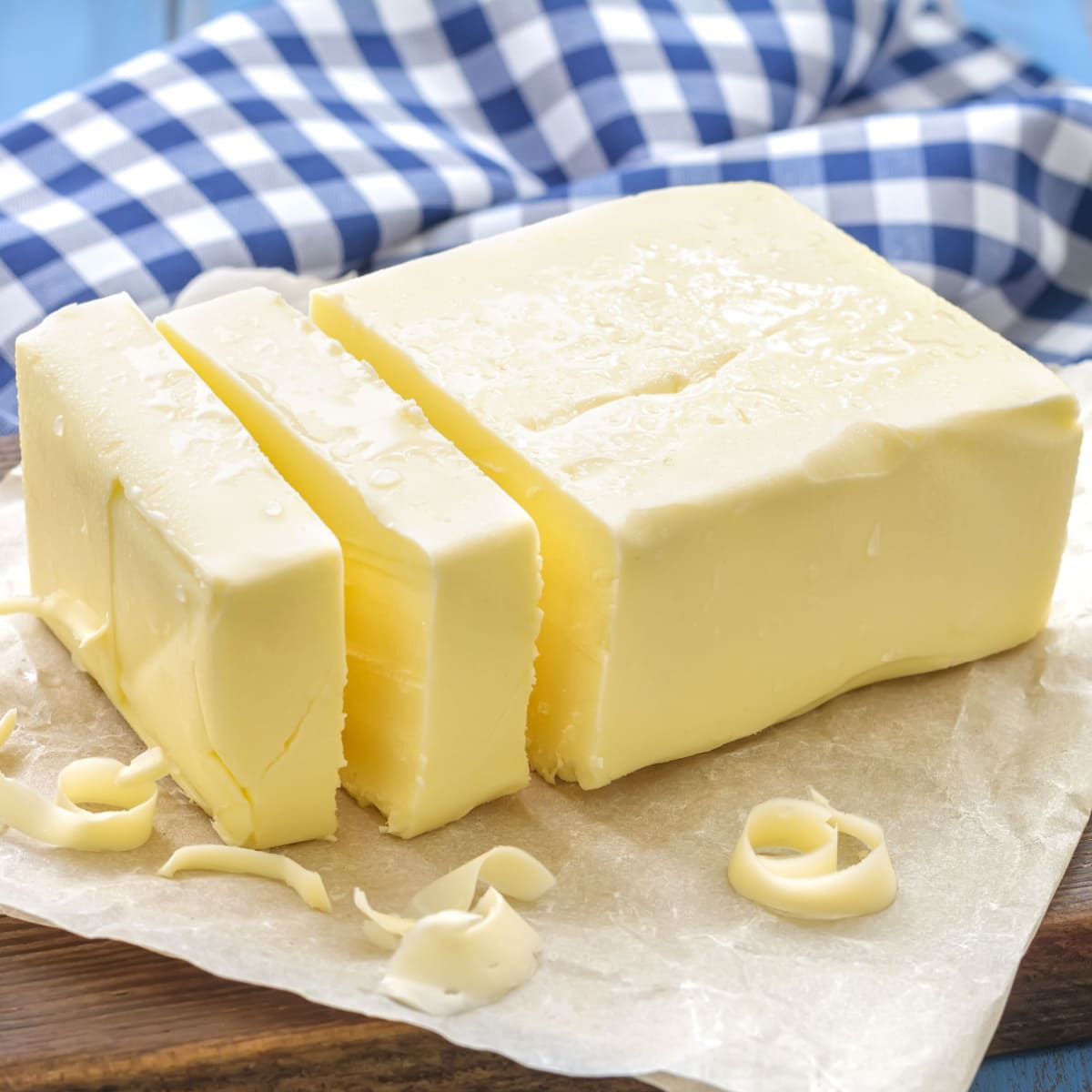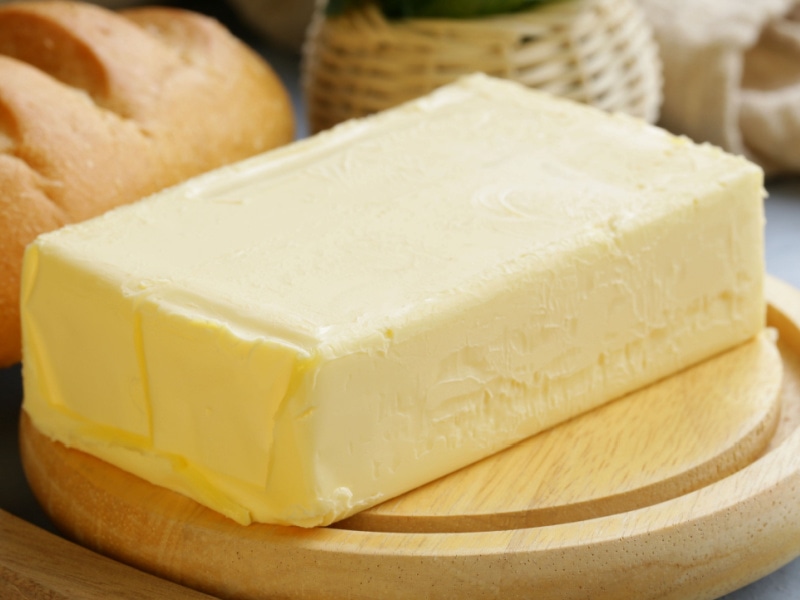To soften butter quickly, cut it into small pieces or grate it. You can also place the wrapped butter stick in a Ziploc bag and gently pound it with a rolling pin.
To soften butter in the microwave, do so in 5-second intervals. Turn it each time until it’s soft but not melted. For a slower method, leave butter at room temperature for 30 minutes to an hour.

Softened butter is a staple whether you’re using it for baked goods or other culinary creations. But softening butter can be tricky, and getting the right consistency requires some finesse.
Let’s go over seven easy methods to soften butter to the perfect consistency.
How to Soften Butter at Room Temperature
Imagine it’s a cozy Sunday afternoon. You’re poised to embark on a grand baking adventure. The first item on your recipe list is to soften a block of cold, firm butter. The easiest, most straightforward way is to leave the butter on the counter.
Place that block of butter on your kitchen counter. As you gather the rest of your ingredients, it sits there, gradually softening to the room’s warmth.
It’ll transition from a brick-like firmness to a soft, spreadable texture. This method will take anywhere from 30 minutes to an hour, depending on the warmth of your kitchen.
The result is a soft butter, ready to blend seamlessly with the rest of your ingredients.

How to Soften Butter Quickly
- Cut It Into Cubes
Cut your block of butter into small cubes, around 1 cm or so in size. This will allow the butter to soften more quickly than if left as a single block.
Spread out the cubes on a plate to maximize their exposure to room temperature. Within 15-20 minutes, the cubes should reach a workable softness.
- Grate It
You can grate the butter into thin shreds using a standard cheese grater. The thinness of each shred allows the butter to warm quickly.
Within 10-15 minutes, you’ll have soft, easily workable butter. Be careful while grating to avoid potential injury.
- Pound It with a Rolling Pin
Place your butter between two pieces of parchment paper or inside a zip-top bag. Use a rolling pin to pound and roll out the butter.
The pressure and manipulation will warm the butter, breaking its structure and softening it. This method is quick and should only take about 5-10 minutes.
- Make a Hot Water Bath
Fill a bowl with hot (but not boiling) water. Place your butter in a heat-resistant zip-top bag, ensuring it’s sealed tightly.
The butter will absorb the heat from the water, softening without melting. This process should take about 5-10 minutes.
Dry off the bag before opening it to avoid getting any water in your butter.
- Use Indirect Heat
If your oven is on, you can use the heat to soften your butter. Place the butter on a plate in the kitchen near where your oven vents heat.
Ensure it’s not too close, or it could start to melt. The ambient heat should help soften the butter in about 10-15 minutes.
- Microwave It
This method should be used as a last resort, as it’s easy to melt the butter accidentally.
If you’re in a hurry, place the butter in a microwave-safe dish and microwave it for 5-10 seconds at a time on low power. Be sure to check it between intervals.
The key here is short bursts of heat to avoid a butter puddle. This method can soften your butter in under a minute.
But be careful, as too much heat too fast can change the butter’s consistency.

How Can You Tell When Your Butter Has Softened?
Knowing when your butter has reached the right level of softness is crucial. It can impact the overall quality of your recipes.
Here are some ways to tell if your butter is perfectly softened:
1. Touch Test
Gently press your finger onto the surface of the butter. It’s perfectly softened if it yields slightly under gentle pressure and leaves an indentation.
If your finger slides easily into the butter or feels oily, it’s too soft.
2. Poke Test
Use a knife or a toothpick to poke the butter lightly. If it goes in with slight resistance, your butter is softened to the correct consistency.
If there’s no resistance, the butter is too soft.
3. Room Temperature
Ideally, softened butter should be around 65-67°F (18-19°C). This temperature is generally considered room temperature in baking.
If you have a kitchen thermometer, you can use it to check the temperature of your butter.
4. Visual Test
Properly softened butter should hold its shape but not be melty or glossy. It should still look solid rather than liquid.
Remember, softened butter is important in recipes because it blends better with other ingredients.
Too hard, and it won’t blend properly. Too soft, and it will cause your baked goods to be flat or greasy.
Why Bother Softening Butter
Softening butter is important in many recipes, particularly those requiring creaming butter and sugar together. The reasons are rooted in the science of baking.
Softened butter is much easier to mix with other ingredients. If the butter is too cold, it won’t blend well with the other components of your recipe. It’ll lead to a mixture that’s unevenly combined.
It also helps to achieve the right texture. For example, cookies can spread too much with melted butter or not enough with cold butter.
While it might seem like a small thing, butter can significantly impact your recipe’s success. Taking the time to soften butter to the right consistency can make all the difference.

Can You Leave the Butter Out Overnight to Soften?
Yes, you can leave the butter out overnight to soften. Butter doesn’t spoil quickly due to its high fat and low water content. Leaving it out at room temperature for a short period, such as overnight, is typically safe.
But if your room temperature is hot, your butter may get too soft or melt. In this case, it’s better to soften it for a shorter period at room temperature.
While it’s safe to leave butter out for a while, it’s not recommended to leave it out for prolonged periods. This is especially the case in a warm environment. The butter could become rancid.
In any case, use your best judgment and consider the specific circumstances in your kitchen. If the butter looks or smells off in any way, it’s safer to discard it.









